
 Data Structure
Data Structure Networking
Networking RDBMS
RDBMS Operating System
Operating System Java
Java MS Excel
MS Excel iOS
iOS HTML
HTML CSS
CSS Android
Android Python
Python C Programming
C Programming C++
C++ C#
C# MongoDB
MongoDB MySQL
MySQL Javascript
Javascript PHP
PHP
- Selected Reading
- UPSC IAS Exams Notes
- Developer's Best Practices
- Questions and Answers
- Effective Resume Writing
- HR Interview Questions
- Computer Glossary
- Who is Who
Meaning of Demand and Factors Affecting Demand
What is Demand?
Demand refers to a consumer's desire and ability to buy a product. This is known as individual demand. If all individual demands of a market are added together, then we get the market demand. Although these two are the most important and popular forms of demand, there are other types of demand too.
Demand is the most basic tool in economics that is central to the idea of economics as a whole. Without demand, the markets will stop functioning, and hence, we won't be able to run our societies. Demand is regulated by two laws, namely, the law of demand, and the law of diminishing marginal utility.
Law of Demand |
Law of Diminishing Marginal Utility |
|---|---|
The law of demand establishes a relationship between demand and price. It states that when all other factors remain constant, an increase in the price of a product will reduce its demand while if the price is reduced the demand will increase. |
The law of diminishing marginal utility states that demand is highest at the beginning which is called the utility of the product demanded. |
This law indicates that companies must find the right price for their products to sell in the market. |
The utility of products goes down when they are used continually. |
For example, if companies overprice the product, its demand will come down whirl in underpricing, demand will go up but profitability may come down. Therefore, there is a need of estimating the supply required in a market for the companies to optimize their production and profitability. |
For example, when there is a desire for eating ice cream, the first cone will have the most utility. Any successive cone will have reduced desirability or utility. Therefore, with continued use, the demand for successive items goes down. |

Types of Demand
Demand can be classified into several categories depending on the users, nature, location, utility, etc. However, the most common types of demand are the following:
Individual and Market Demand

Individual demand is the demand of an individual.
For example, if someone needs 5 kilos of what in a month, the individual demand here is 5 kilos for wheat. The market demand is the total demand of a market. For example, if there are three individuals in a market having a demand of 5 kilos, 3 kilos, and 2 kilos of wheat for a month, their market demand will be 5 +3 + 2= 10 kilos for the month.
Organization and Industry demand
Organizational demand refers to the demand for an organization's products in a market.
For example, the demand for Britannia biscuits is an organizational demand of Britannia. However, when it is considered for the entire industry, the demand is known as industry demand.
For example, when products of all market players like Parle, Bisk Farm, Cadbury, etc. which produce biscuits are considered it is called industry demand.
It is hard to differentiate organizational and industry demand in a highly competitive market as no firm has a greater market share so there is hardly any importance on an individual firm's share of demand.
Autonomous and Derived Demand
Autonomous demand is not dependent on any other factor. The products that are indispensable for a living usually have autonomous demand.
For example, the demand for agricultural products we need for living falls in this category.
Derived demand depends on the demand for another commodity or product.For example, the demand for computer chips is dependent on the production of computers. So, computer chip demand is derived demand.
Income Demand
Demand related to an individual's income is called income demand.
For example, when the income increases, a person wants to buy more high-income items. Therefore, the demand for these items goes up which is an increase in income demand.
Price Demand
Price demand refers to the demand for a product at any given price of a product at a certain period of time.
For example, if an umbrella's price in a market in the monsoon season is Rs 300, the demand for the product at Rs 300 is its price demand.
Demands for Durable and Perishable goods
Perishable goods are the ones that have only use like fuel, food, etc. The demand for perishable goods is known as perishable goods demand. On the other hand, the demand for goods that can be used multiple times is known as durable goods demand. Some durable goods include clothes, PCs, and machinery which can be used many times.
Cross Demand
Cross-demand is the form of demand that is related to similar items' prices. When the price of an item increases, the cross-demand for similar items may go up.
For example, a cross-demand can be found in the prices of tea and coffee. When the price of one item (say, coffee) increases, people switch to the other item (tea) which increases the latter's demand.
Seasonal and Long-term Demand
Seasonal demand refers to the demand for the items that are used seasonally.
For example, refrigerators are primarily demanded in the summer season when temperatures go up. On the other hand, products that have a long-term demand such as durable goods fall under the long-term demand category.
Factors Affecting Demand for Products
Promotion Promotion and marketing of products can have a significant improvement in their demands in a specific market. Many products that are newly launched have technologies or uses that must be shared so that people can use them. Marketing can help in such situations.
Income The income of the consumers also plays a vital role in the demand for products in a market. For example, when income increases, people tend to buy more luxury goods so the demand for luxury goods goes up.
Price change As mentioned above, price change impacts the demand inversely. Increasing price decreases demand and vice versa.
Choice of consumers Consumer choice and preference may change with time. This may impact the demand for select items. This is applicable to tech products, such as mobile phones and laptops.
Market size The size of the market can also impact the demand in that market for a product. When the market size is bigger, the demand will be more than general, usually.
Conclusion
Demand is the basic requirement of business and economics and without it, modern economies cannot function. Demand and supply are two conditions depending on which modern businesses operate. Therefore, learning about demand and supply is important for everyone considering doing business or getting an insight into a select market.
FAQs
Qns 1. What is meant by demand? What are individual and market demands?
Ans. Demand refers to a consumer's desire and ability to buy a product. This is known as individual demand. If all individual demands of a market are added together, then we get the market demand.
Qns 2. What are the basic two laws related to the theory of demand?
Ans. Demand is regulated mainly by two laws -the law of demand, and the law of diminishing marginal utility.
Qns 3. What is the most influential factor for the increase and decrease in demand?
Ans. Change in price is the most influential factor for the increase and decrease in demand.

